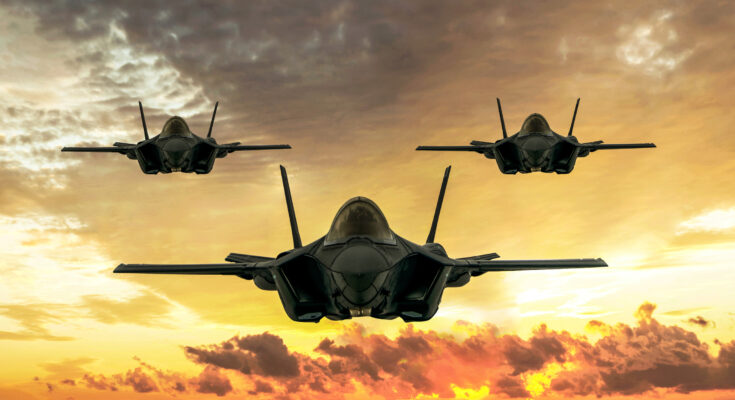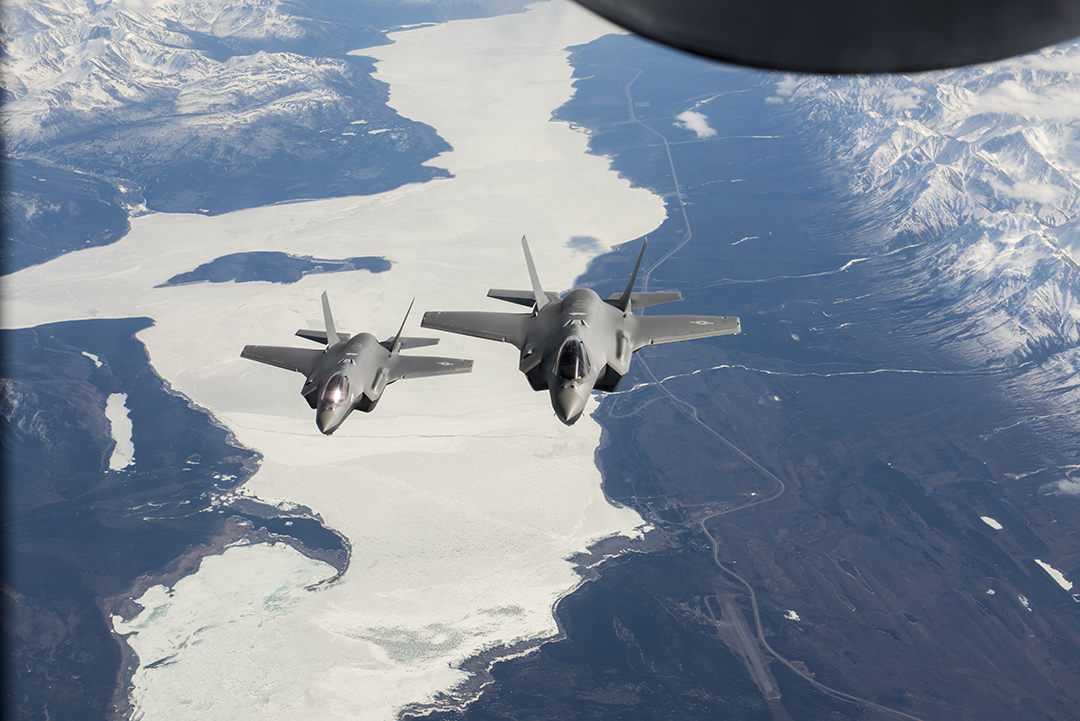
THE WATCH STAFF
The barren and unforgiving Arctic terrain of the Joint Pacific Alaska Range Complex (JPARC) is where the United States military and its allies train in extreme conditions.
High above the vast landscape that is the size of the U.S. state of Indiana, the world’s most advanced warplane — the F-35A II Lightning stealth fighter — conducts operations, too.
The multirole F-35A II rules its domain no matter the environment.
“We have a motto that ‘we’re ready to go at 50 below [zero degrees Fahrenheit],’ ” and it does get that cold sometimes, Col. David Berkland, commander of the 354th Fighter Wing at Eielson Air Force Base (AFB) in Alaska, said during an August 10, 2022, event at the base, according to the Insider news website.
The U.S. released its new Arctic strategy in October 2022 that makes countering the moves of Russia and the People’s Republic of China (PRC) in the region a priority as the sea ice melts and shipping lanes open. The Pentagon seeks to increase its presence through military exercises with allies modernizing air defenses. The F-35A will play a key role in this deterrence.
Eielson AFB was the first cold-weather U.S. Department of Defense (DOD) installation to get the fighter, which manufacturer Lockheed Martin had subjected to Arctic temperatures during its development. Alaska is a strategic gateway to both the Polar Arctic and to the Indo-Pacific.
But the F-35A has the capability to deter potential adversaries far beyond the foreboding environment of JPARC. From Eielson, the long-range supersonic fighter can reach anywhere in the Northern Hemisphere in one sortie.
When the 54th F-35A was delivered to Eielson AFB in April 2022, the state became the nexus of fifth-generation fighter operations. The 354th FW’s two squadrons of F-35As are complemented by two squadrons of F-22s stationed at Joint Base Elmendorf-Richardson. That is the world’s largest concentration of advanced warplanes.
Gen. Charles Q. Brown Jr., the U.S. Air Force chief of staff, has called the F-35A the “cornerstone of air superiority” for the U.S. and its allies and partners. Currently, more than a dozen nations either operate the F-35A and its variants — F-35B (short takeoff/vertical landing) and F-35C (aircraft carrier operations) — or have ordered the single-seat warplane.
Brown said the F-35A’s capabilities outpace those of potential adversaries.
Of those, its primary advantage is stealth.

The F-35 fighter represents a new model of international cooperation, ensuring the security of the U.S. and its partners well into the 21st century. TECH SGT. ADAM KEELE/U.S. AIR NATIONAL GUARD
“The plane’s shape [and surfaces are] designed to deflect radar energy away from the source like a slanted mirror,” Paul Poitras, director of survivability at Lockheed Martin’s Skunk Works, said in a story from the aerospace manufacturer published by The Washington Post newspaper. “Its surface is also blended and smoothed to enable radar energy to smoothly flow across it — similar to water … across a smooth surface.”
Then there is the F-35A’s “sensor fusion,” which Lockheed Martin calls the most advanced in the world. This suite of electronics lets pilots draw on information from all onboard sensors to create a single integrated battlefield picture that enhances domain awareness. This view critically allows F-35A pilots to see first and shoot first.
“The plane’s computer system synthesizes and prioritizes the information and tells me who the good and bad guys are,” Billie Flynn, a senior experimental test pilot with Lockheed Martin, said in the Lockheed Martin story. “That makes my workload less than was ever the case in any generation of fighter before.”
The pilots see those bad guys on state-of-the-art helmets that seem more akin to virtual-reality headsets. The helmets cost an estimated $400,000 each — more than four times as much as those of the previous-generation F-16 — according to a 2015 report in the USA Today newspaper. All the information pilots need to carry out missions — airspeed, heading, altitude, targeting data and warnings — is projected onto the visor, rather than a traditional heads-up display in the cockpit. “I am never overwhelmed by data,” Flynn said.
That allows the F-35A to overwhelm its adversaries, whether it is operating in air defense, close air support, tactical bombing or in one of its many other roles.
“The pilot sees everything that’s of concern to him on the ground and to the horizon, even to the point where he can look … underneath the airplane and see all the way to the ground,” Flynn said of sensors embedded in the F-35A that through its Distributed Aperture System (DAS) and infrared cameras give pilots a 360-degree view outside the cockpit on their helmet visors.
This sensor integration helps bring unparalleled situational awareness, information-sharing and connectivity to the North Atlantic Treaty Organization (NATO) members and other U.S. allies and partners who fly the F-35A. This capability is critical in joint domain operations.
The F-35 nests its weapons internally in stealth configuration and can also carry them externally if the environment allows. All variants can deliver the Joint Air-to-Surface Standoff Missile (JASSM) or Long Range Anti-Ship Missile (LRASM), which give the fighters reach against heavily protected targets and deterrence against potential adversaries. The F-35A is also armed with a 25 mm GAU-22/A rotary cannon for ground targets during close ground support.
The F-35 uses an Active Electronically Scanned Array radar, or AESA, which provides long-range intelligence. Lockheed Martin says the F-35 serves as an “information and communications gateway” that can share its operational picture with U.S. and allied land, sea and air forces. It can also engage in electronic warfare with adversaries through its ability to track enemy forces, jam radar and disrupt attacks.
Recently, the F-35A became even more lethal. On September 29, 2022, the Air Force Nuclear Weapon Center approved the initial nuclear design certification for the fighter, the service said in an email to The Watch. Once it receives operational nuclear certification, it will be able to deliver the B61 thermonuclear bomb, according to the Sandia National Laboratories. A 2020 U.S. DOD publication calls for the initial deployment of such dual-capable F-35As in 2025.
The PRC and Russia are seeking to match the F-35A’s capabilities now that it has become the “global standard for tactical air power,” according to a March 4, 2021, story in the National Interest magazine. The adaptable F-35’s technology, however, is frequently upgraded as new threats appear.
As Air Force Lt. Gen. Scott Pleus, the former director of the F-35 integration office, summed up the warplane in 2016 to the Insider news website:
“This is an absolutely formidable airplane,” he said, “and one our adversaries should fear.”
